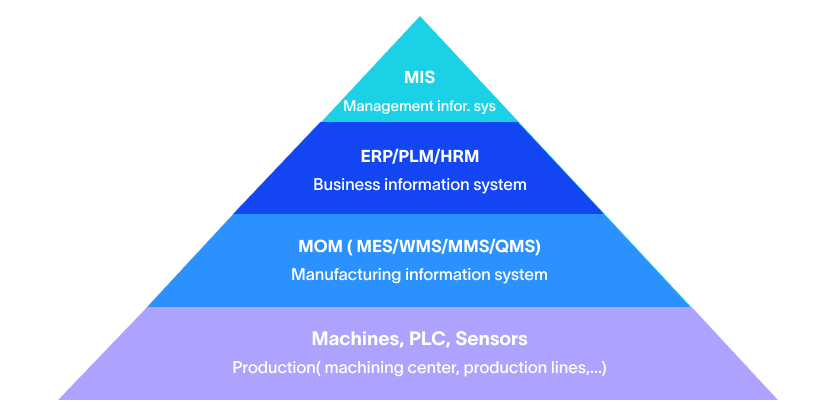The Truth About Generative AI in Manufacturing: Enhancement, Not Replacement
Blog
5 Min 17 Sec Read
AI Is Evolving—But Are Traditional Analytics Dead?
The manufacturing industry is losing its mind over the hype regarding generative AI. LinkedIn streams are filled with speculation that AI will surpass traditional systems with plant managers wondering: Will embracing generative AI, particularly in manufacturing, really render the dashboards and analytics they’ve relied on for decades obsolete?
At INS3, with 30+ years of experience dealing with manufacturing data analytics, our response is straightforward: generative AI is not arriving to replace your legacy analytics—it’s arriving to make them a lot more effective.
The truth? Successful digital transformation is a marriage of old and known approaches and new capabilities, not obsolescence by the latest fad.
Transform Complex Data into Strategic Wins – Discover How Top Operations Leaders Use Manufacturing Analytics to Scale Efficiently
How does Traditional Manufacturing Analytics Remain to be the Foundation?
What Traditional Analytics Include?
- Real-time production metrics and equipment status dashboards: Interactive dashboards give you essential production metrics and real-time equipment condition. These enable you to glance at performance. So, with real-time visibility into information, you can identify bottlenecks, make process improvements, and run your operations more efficiently.
- Historical trend analysis for patterns of long-term performance: With the evaluation of historical data, organizations can recognize long-term performance trends as well as recurring problems. Historical trend analysis helps in taking improved decision-making for process improvement and strategic planning, thus ensuring improved efficiency in operations in the long term.
- Statistical process control (SPC) charts for quality consistency: SPC charts monitor production processes and maintain the quality at a satisfactory level. Since they have the capability to monitor variation and identify outliers, the manufacturers can adjust potential quality issues in advance before these are responsible for problems, thus less wastage and happier customers.
- Rule-based alarm systems for critical condition notifications: Sophisticated alarm systems are available for notifying operators of critical situations that require timely response. Rule-based alarm systems utilize real-time information and warn on out-of-range conditions to provide timely intervention to prevent costly downtimes or safety hazards.
- OEE calculations measuring equipment effectiveness: Overall Equipment Effectiveness (OEE) calculations provide an overall measure of manufacturing productivity. Measuring availability, performance, and quality, companies can see where they can make changes and improve the effectiveness of their equipment, producing more with less cost.
- KPI reporting for operational performance: You can systematically report KPIs to evaluate operational performance against established targets. It gives you the power to analyze performance trends, gain insights into operational effectiveness, and drive continuous improvements that align with your organizational goals.
Cut Costs, Not Corners – See How Data-Driven Insights Are Revolutionizing Efficiency and Waste Reduction in Manufacturing.
Why These Remain Essential?
Reliability: Reliable, predictable outcomes from time-tested methods. If an SPC chart indicates signs of pump failure, you can rely on that diagnosis.
Explainability: Each calculation and alarm is traced back to original data and rules—critical for regulatory compliance and operator trust.
Proven ROI: Decades of track record enhancing efficiency, minimizing downtime, and upholding quality standards.
A Used Case to Help
A chemical factory employs conventional analytics for real-time reactor monitoring, automated safety actions, and regulatory adherence. Such systems operate consistently per shift. In these cases, you can get help from generative AI to improve interpretation but not substitute basic real-time process monitoring.
Discover How Industry Leaders Are Using AI to Minimize Downtime and Maximize Uptime—Explore the Executive Guide Today.
What’s the Real Role of Generative AI in Manufacturing?
Generative AI for manufacturing is more than just chatbots, providing certain features that enhance existing systems:
Key Features:
- Automated Reporting: Translating sensor readings into descriptive reports detailing production occurrences
- Improved Predictive Models: Adding unstructured information such as maintenance records and operator comments
- Root Cause Analysis: Correlating many sources of data together for cause-and-effect insights
- Process Optimization: Determining points of potential efficiency gain from patterns of production
- Custom Visualizations: Producing charts in response to natural language queries
Unlock the Full Potential of Your MES—See How It Powers Scalable AI and Analytics Across Manufacturing Operations.
Where Generative AI Excels: Three Key Areas
Bridging Data Gaps
AI in manufacturing analytics incorporates unstructured information—maintenance logs, weather data, supplier reports—providing context traditional systems miss.
For instance, a food processor’s quality variations couldn’t be explained by traditional analytics. In this case, generative AI helps the manufacturer to correlate maintenance logs, humidity data, and supplier schedules, revealing that quality dips occurred during high-humidity maintenance windows.
Accelerating Insight Discovery
With machine learning in production, you have the ability to use algorithms to handle vast amounts of data in an efficient and timely way. This allows you to rapidly try many hypotheses about production processes, equipment utilization, and product quality.
Rather than using human analysts that can take weeks to go through the data and identify trends or patterns, machine learning can go through this data within minutes, a fraction of the time. This allows manufacturers to make decisions based on real-time, up-to-date data, minimize operations, and ultimately maximize efficiency and productivity. Thus, by revealing patterns that are not straightforwardly seen, machine learning aids organizations in remaining competitive and responsive to market change.
Augmenting Human Decisions
Instead of taking automated action, AI gives contextual suggestions that merge algorithmic data with human insight.
For example, in production exceptions, classic dashboards would display normal pressure/temperature but decreasing quality. But through AI, you can relate such patterns, and it will propose that you check a certain valve which can save you hours of debugging.
Gain the Edge—See How Leading Manufacturers Turn Data into a Strategic Advantage with Advanced Analytics
INS3's Hybrid Approach: Best of Both Worlds
We implement smart manufacturing technologies by strategically combining traditional and AI analytics:
Real Implementation Case:
Pharmaceutical Client Challenge: Improve batch consistency while maintaining FDA validation.
Our Solution:
- Traditional Foundation: Maintained existing MES, historians, and validated SPC procedures
- AI Enhancement: Added AI analysis of batch records and environmental data
- Integration: AI recommendations appear within existing dashboards
Results:
- 15% improvement in batch consistency
- 40% reduction in investigation time
- Full regulatory compliance maintained
- 90%+ operator adoption
Practical Implementation Guide
Phase 1: Foundation (Months 1-2)
- Audit existing analytics and data quality
- Identify traditional system pain points
- Ensure data infrastructure supports AI
Phase 2: Strategic Pilot (Months 3-4)
- Select low-risk, high-value AI use cases
- Implement alongside traditional systems
- Focus on human decision enhancement
Phase 3: Validated Integration (Months 5-6)
- Expand successful pilots
- Develop staff training programs
- Create AI governance processes
Implementation Best Practices:
Don’t Replace—Enhance: Layer AI over traditional dashboards and KPIs as your operational foundation.
Maintain Transparency: Ensure AI recommendations include reasoning and confidence levels.
Start Small: Begin with non-critical applications before tackling mission-critical processes.
Invest in Training: Help operators understand how to effectively use AI-enhanced analytics.
Industry Applications
Pharmaceuticals: AI analyzes batch records while traditional systems maintain validated compliance.
Food & Beverage: AI correlates environmental factors with quality; traditional systems handle food safety monitoring.
Chemical Processing: AI identifies optimization opportunities; traditional systems manage safety interlocks.
Automotive: AI predicts quality across supply chains; traditional systems control real-time production.
Step Into the Future—Explore How AI, IIoT, and Data Analytics Are Revolutionizing Smart Manufacturing Today.
Avoiding Common Pitfalls
- Over-Automation: Don’t let AI make critical decisions without human validation
- Data Quality Neglect: Clean your data foundation before adding AI
- Unrealistic Expectations: AI enhances expertise; it doesn’t replace manufacturing knowledge
- Change Management Failures: Ensure proper training for both traditional systems and AI toolsLorem ipsum dolor sit amet, consectetur adipiscing elit. Ut elit tellus, luctus nec ullamcorper mattis, pulvinar dapibus leo.
The Future is Strategic Integration
The question isn’t whether generative AI will supplant traditional manufacturing analytics—it won’t. Success is in the strategic integration of both methods.
What does Traditional Analytics Offer?
It demonstrates reliability tested and standards compliance, which is an indication that it is up to all the correct standards and regulations. It demonstrates capability for real-time control, whereby it can adjust and monitor in real-time. Additionally, its results are readable and immensely easy to understand, which are aspects making it easy for the manufacturers to make a decision and obtain favorable results.
What are the Contributions of Generative AI?
The system relies on established reliability and regulatory compliance, which makes it reliable to operate. The system has real-time control, ensuring there are instant adjustments and pro-active control. Just as the conventional twin, in this one also you will have clear transparent results that enable you to comfortably interpret and understand the results.
What Difference does INS3 Bring?
At INS3, we guide manufacturers through this hybrid future with tested methods, not hype. Our process assures leading-edge AI payoffs while preserving reliability of operation and adherence to regulation.
Experience Real-Time Intelligence—See How Edge Analytics Is Driving Smarter, Faster Manufacturing Decisions.
Ready to Enhance Your Analytics?
At INS3, we bridge the divide between AI hype and actual implementation, placing real-world knowledge in the spotlight of your technology modernization. With seamless integration into existing analytics and AI, we make it possible for organizations to operate their businesses effectively without any disruption.
Discover how our Manufacturing Data Analytics will enhance your plans and schedule a consultation to discuss your AI-readiness plan. Tomorrow is not about swapping the good stuff for something else but making it better so that it can perform better. Join us and unleash your potential.

Agile MES: The Key to Unlocking Smart Manufacturing Success
MES is a computerized system used in manufacturing operations to track and document the transformation of raw materials into finished goods. An MES system typically manages and monitors work orders, equipment, materials, and personnel on the shop floor. The system provides real-time visibility into production processes, helps optimize manufacturing operations, and improves the overall efficiency of the manufacturing process.

Understanding OEE: The Key to Manufacturing Efficiency
In today’s competitive manufacturing landscape, improving efficiency and productivity is crucial for businesses to remain competitive. One of the key metrics used to measure manufacturing efficiency is OEE or Overall Equipment Effectiveness. In this blog, we will take a closer look at OEE and its importance in manufacturing.

How to Effectively Conduct a Legacy System Integration
Legacy system integration can be a daunting task, but it’s a necessary one for many manufacturers that rely on outdated systems to run their business. Integrating legacy systems with modern technology can improve efficiency, streamline processes, and save time and money. However, it’s important to approach the integration process carefully and methodically to ensure success.
Share on :
Keep On Reading
Subscribe to Our Newsletter
Subscribe to our weekly newsletters to get updates regarding our new production, behind the scene process of our art creation and much more.
After submitting this form you will receive an e-mail with a confirmation link that you must click to complete your request. Detailed information on processing and cancellation can be found in our privacy policy.

